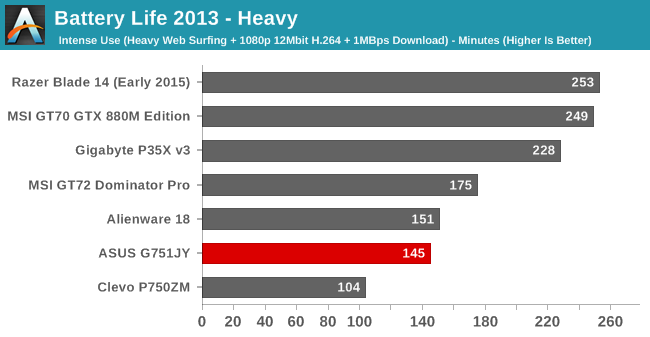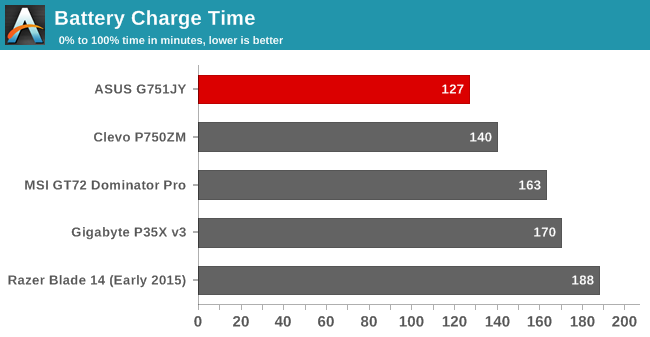The ASUS Republic of Gamers G751 Review: G-SYNC Comes To The Notebook Computer
by Brett Howse on July 29, 2015 8:30 AM ESTBattery Life and Charging
Most of us would not think of a 8.5 lb notebook as something that is overly portable, but there still might be an occasion where the G751 would need to be off the mains for a bit. NVIDIA has done some work on battery powered gaming, but their biggest issue to overcome is that most of these gaming notebooks do not get great battery life even under light workloads, so gaming generally means an hour or less of battery life, and that is with reduced performance as well.
The G751 comes equipped with a 90 Wh battery, which is certainly on the large side but not unexpected with a large chassis notebook.
Our light battery life test consists of web browsing, with the display set at 200 nits. Time is logged until the device powers down. The heavy test ramps up the number of pages loaded, adds in a 1 MB/s file download over Wi-Fi, and also includes a movie playback.

If the G751 has an Achilles heel it is battery life. Although we can't isolate power consumption of the laptop's GTX 980M discrete GPU, based on the performance of other large gaming laptops I believe the bulk of the battery life hit comes from the lack of Optimus support. Without any Optimus support, or a hardware switch to disable the GPU like the MSI GT80 has, the ASUS G751 is dragged down by having to power far more graphics power than is necessary to browse the web. These devices are not really designed to be used on the go like a smaller Ultrabook would be, but here we can see pretty clearly that there is a lot of work to be done for the Maxwell GPUs to get close to integrated GPUs low power usage.

It is pretty much the same story on the heavy test. Only the Clevo manages worse battery life, and it has a desktop processor inside of it. A ten pound notebook is already not very portable, so the battery life scores are certainly not as relevant as they would be on many machines.


With a 47 watt quad-core Haswell processor, a powerful GPU which can’t be completely disabled, and no real requirement to be efficient, the G751 is closer to a desktop replacement than other similar devices. Like a desktop, this laptop should be plugged in for pretty much any usage. If you wanted to watch a movie on it, you could get by as long as it isn’t Lord of the Rings (the extended version of course). But if you are going to have a knock on a device like this, battery life is likely the one area that is not as critical to the experience.
Charging
ASUS ships the G751 with a 230 watt A/C adapter, which should be plenty to cover the peak power usage of the laptop. With a 47 watt processor and a GPU that will draw somewhere around 100 watts, there is still a nice margin even if the device is fully loaded up. This also leaves quite a bit of power available to charge the large 90 Wh battery.

Despite the huge battery, ASUS manages to charge up very quickly, with the G751 being right at the top of any device we’ve tested. In fact the only device that charges quicker is the Lenovo ThinkPad X1 Carbon, and it has just a 50 Wh battery inside, so ASUS slightly makes up for the less than stellar battery life by at least getting back up to full charge quickly.
All in all, the battery life is poor, but with G-SYNC requiring that the GPU be directly connected to the display, rather than through the integrated GPU, there is no possibility for Optimus to be used. Some devices have a hardware multiplexer to enable the integrated GPU to be used, but it adds cost and complexity to the laptop, and you would lose access to G-SYNC on the desktop too in that case. With these handicaps, ASUS has tried to compensate with a large battery, but in the end the device is just not that power efficient, but its use targeted audience is likely not too worried about that.










52 Comments
View All Comments
Meaker10 - Wednesday, July 29, 2015 - link
Indeed, the only way to get around this is to do what MSI have done and have a manual switch and on reboot move the traces over and run in IGP mode (without G-sync of course).Asus also only had the later G750 with optimus, before they actually avoided it generally in their 17 inch models. So really for asus the optimus models were a blip rather than a trend.
nerd1 - Friday, July 31, 2015 - link
Many laptops had hardware mux to switch GPU pre-optimus era (alienware had one) which is a way better solution than optimus.nightbringer57 - Wednesday, July 29, 2015 - link
As a matter of fact, everyone has been building some non optimus notebooks all the time.The Optimus technology requires the screen to be directly driven by the integrated GPU. Some custom technologies made by GPU manufacturers require the screen to be driven by the GPU himself. That's why the 3D laptops never sold, because Nvidia's 3D technology requires the screen to be driven by the nvidia GPU directly, so you can't have an Optimus-enabled 3D screen laptop (well, at least using nvidia 3D).
The same problem is true for G-Sync. So you can't technically have G-sync and optimus on the same laptop.
BMNify - Wednesday, July 29, 2015 - link
Exactly, the optimus tech even effects VR and you can't drive VR with igpu, many high end laptops are now coming without optimus due to customer demand.BMNify - Wednesday, July 29, 2015 - link
Optimus tech is reviled in the hardcore gaming community and gaming forums who pay $2000 plus for gaming laptops, many top-end gaming laptops have no optimus due to Customer demand !!Notmyusualid - Saturday, August 1, 2015 - link
^ This is true.Many don't buy a machine due to the very fact that Optimus is there.
However, I have a Dell M3800 HD4600/K1100M that has no issue with it.
boeush - Wednesday, July 29, 2015 - link
OK, bit why would anyone buy this now, when Skylake is right around the corner? Wait another couple of months, and an equivalent model with a better CPU and DDR4 is all but guaranteed by the holiday shopping season. Or, at the very least, this particular model will be selling at deep discounts by then...boeush - Wednesday, July 29, 2015 - link
Not to mention, a premium laptop this far into 2015, and with not a single USB 3.1 port? Tsk, tsk...meacupla - Wednesday, July 29, 2015 - link
because, you buy it when you need it, not when there is something new 'in a couple of months'.A week, sure, that's not a long wait, but 2 months to launch means you're going to be waiting another 6 months until the replacement for this type of gaming laptop to appear on the market.
boeush - Wednesday, July 29, 2015 - link
According to various leaks, Skylake H is launching in October. Skylake T (low voltage 35W i7 6700) is also launching about then or even sooner.Given that, why would anyone NOT expect all brands to refresh models with Skylake by Black Friday?? Any brand that fails to do that, is going to lose out huge this year.
So sure, retail availability of bixed CPUs is October, but I'll bet all the OEMs have had samples under NDA since spring, and are working to deliver updated models on the same day as the CPU launch.